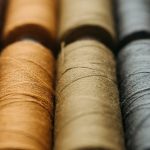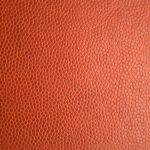You’ll find polypropylene is a relatively strong fabric, offering tensile strength from 3,000 to 5,000 psi, which makes it stronger than natural fibers like cotton or wool. It resists abrasion, moisture, and many chemicals, keeping its durability even under heavy use. Polypropylene’s strength also benefits from fabric weave and thickness, improving its performance in tough conditions. If you want to understand how these factors and applications impact its reliability, there’s more to explore ahead.
Table of Contents
Key Takeaways
- Polypropylene has tensile strength between 3,000 and 5,000 psi, stronger than cotton and wool but weaker than nylon and polyester.
- It maintains strength under tension, resisting tearing and fatigue for durable and flexible applications.
- The fabric offers excellent abrasion resistance, ideal for high-friction environments without significant wear.
- Polypropylene resists moisture, chemicals, and varying climates, preserving its strength and durability over time.
- Fabric weave, thickness, and density further influence polypropylene’s overall strength and suitability for specific uses.
Understanding Polypropylene as a Synthetic Fiber
Although you mightn’t realize it, polypropylene plays an essential role in many everyday products due to its unique properties as a synthetic fiber.
When you encounter polypropylene fabric, you’re dealing with a material known for its lightweight nature and resistance to moisture, making it ideal for activewear and outdoor gear. You’ll notice it doesn’t absorb water like natural fibers do, so it dries quickly and resists mold and mildew.
Plus, polypropylene resists stains and chemicals, so it keeps looking fresh even after repeated use. Its thermal insulation properties help regulate temperature, so you stay comfortable in various conditions.
Polypropylene resists stains and chemicals while providing thermal insulation for lasting comfort in any condition.
Understanding these characteristics helps you appreciate why polypropylene is a go-to choice in many applications, from clothing to upholstery and industrial uses.
Tensile Strength of Polypropylene Compared to Other Fabrics
You’ll find that polypropylene offers impressive tensile strength for a synthetic fiber, making it a strong contender among fabrics.
When you compare it to materials like cotton or polyester, its durability under tension often stands out.
Let’s explore how polypropylene measures up against these common fabrics in strength tests.
Polypropylene Tensile Strength
When you compare polypropylene to other common fabrics, you’ll find its tensile strength stands out for both durability and flexibility.
Polypropylene fibers can endure significant tension before breaking, making them reliable for various applications. This fabric tends to maintain strength even when stretched, which helps prevent tearing under stress.
You’ll notice that polypropylene also resists fatigue well, so it won’t weaken quickly after repeated use. Its tensile strength ranges typically between 2800 to 4000 psi, which is quite impressive for a lightweight material.
Because of this balance, you can trust polypropylene in products that require toughness without sacrificing comfort.
Whether in upholstery, outdoor gear, or industrial textiles, polypropylene’s tensile strength offers a practical combination of resilience and flexibility.
Fabric Strength Comparisons
While polypropylene offers impressive tensile strength, comparing it to other common fabrics helps you understand its unique advantages and limitations.
Polypropylene typically has a tensile strength ranging from 3,000 to 5,000 psi, making it stronger than many natural fibers like cotton or wool. However, it falls short compared to synthetic fibers such as nylon and polyester, which often exceed 7,000 psi.
If you prioritize lightweight and moisture resistance alongside strength, polypropylene is a solid choice. But if maximum tensile strength is your goal, nylon might serve you better.
Knowing these differences lets you select the right fabric based on your specific needs, whether it’s durability, weight, or cost-effectiveness. This comparison highlights why polypropylene remains popular despite not being the absolute strongest fabric available.
Resistance to Abrasion and Wear in Polypropylene
Polypropylene offers impressive resistance to abrasion and wear, making it a reliable choice for applications exposed to friction and mechanical stress.
When you use polypropylene fabric, you benefit from its ability to withstand repeated rubbing and surface damage without significant degradation. This durability helps maintain the fabric’s integrity over time, even in demanding environments like upholstery, outdoor gear, and industrial textiles.
You’ll notice that polypropylene retains its strength and appearance longer than many other synthetic fibers, reducing the need for frequent replacements. Its resilience also means it performs well under continuous movement and contact, resisting pilling and tearing.
Moisture and Chemical Resistance Properties
Because it resists moisture and many chemicals effectively, polypropylene is ideal for environments where exposure to liquids and corrosive substances is common.
You’ll find that this fabric doesn’t absorb water, which helps prevent mold, mildew, and degradation over time. Its resistance extends to acids, bases, and solvents, so spills or chemical exposure won’t easily weaken the material.
When you use polypropylene in applications like outdoor gear, medical textiles, or industrial filters, you benefit from its ability to maintain strength and integrity despite harsh conditions.
This durability means less frequent replacement and better performance in challenging settings.
If you need a fabric that stays strong even when wet or exposed to chemicals, polypropylene is a reliable choice that won’t let you down.
Impact of Fabric Weave and Thickness on Strength
You’ll find that the type of fabric weave plays a big role in how durable the material is.
Thickness directly affects tensile strength, so thicker fabrics usually hold up better under stress.
Plus, fabric density influences resistance, making it a key factor in overall strength.
Weave Types and Durability
When evaluating material strength, understanding how different weave types influence durability is essential.
You’ll find that tighter weaves, like plain or twill, offer increased resistance to wear and tear compared to looser weaves. This is because the fibers interlock more securely, distributing stress evenly and reducing the chance of snagging or fraying.
For polypropylene fabrics, a tighter weave enhances their natural strength, making them suitable for heavy-duty applications. Conversely, open weaves may feel lighter but sacrifice durability, exposing fibers to quicker degradation under stress.
Thickness Influence on Tensile Strength
Although weave type plays an essential role in fabric strength, thickness greatly affects tensile strength as well. When you increase the thickness of polypropylene fabric, you generally improve its ability to resist pulling forces. Thicker fabrics distribute stress over a larger area, reducing the chance of tearing. However, this relationship isn’t linear—doubling thickness doesn’t always double strength due to factors like fiber bonding and weave tightness.
Here’s a quick comparison of tensile strength across different thicknesses and weave types:
| Thickness (mm) | Weave Type | Tensile Strength (MPa) |
|---|---|---|
| 0.5 | Plain | 120 |
| 0.5 | Twill | 135 |
| 1.0 | Plain | 210 |
| 1.0 | Twill | 230 |
Understanding this helps you choose the right fabric for your strength needs.
Fabric Density and Resistance
Because fabric density combines the effects of weave and thickness, it plays an essential role in determining resistance to various stresses.
When you choose polypropylene fabric, understanding its density helps you gauge durability and strength. A tighter weave means the fibers are packed closer, increasing resistance to tearing and abrasion. Thicker fabrics naturally offer more material to absorb force, but the weave pattern can amplify or reduce this strength.
Balancing these factors guarantees you get fabric that suits your needs, whether for heavy-duty use or lightweight applications.
Keep in mind:
- Tight weaves improve puncture resistance
- Thicker fabrics enhance tensile strength
- Looser weaves may increase breathability but reduce durability
- Denser fabrics resist wear and environmental damage better
- Weave type influences flexibility and strength balance
Choosing wisely helps you maximize polypropylene’s potential.
Polypropylene in Outdoor and Industrial Applications
If you’re looking for a material that combines durability with resistance to environmental factors, polypropylene stands out in outdoor and industrial settings.
You’ll find it in products like ropes, tarps, and geotextiles because it resists moisture, chemicals, and UV damage better than many other fabrics. Its lightweight nature makes it easy to handle without sacrificing strength, so you won’t struggle with heavy loads or cumbersome materials.
Polypropylene’s resistance to mold and mildew means it keeps performing even in damp conditions, which is essential outdoors.
When you use polypropylene, you’re getting a fabric that won’t degrade quickly under harsh elements, ensuring long-term reliability for industrial tasks and outdoor adventures alike.
It’s a smart choice if you want strength and resilience without compromise.
Comparing Polypropylene to Natural Fibers
While polypropylene offers impressive durability and resistance in outdoor and industrial uses, you might wonder how it stacks up against natural fibers like cotton, wool, or jute.
Each fiber type has unique strengths and weaknesses, so it’s important to take into account what matters most for your project.
Consider each fiber’s unique strengths and weaknesses to select the best material for your project needs.
- Polypropylene is generally stronger and more resistant to moisture than cotton or wool.
- Natural fibers tend to be more breathable and comfortable against skin.
- Wool offers excellent insulation but lacks polypropylene’s resistance to chemicals.
- Jute is eco-friendly but less durable and prone to wear.
- Polypropylene resists mildew and stains better, making it ideal for long-term outdoor use.
Knowing these differences helps you choose the right material based on strength, comfort, and environmental needs.
Durability of Polypropylene in High-Stress Environments
When you face high-stress conditions, understanding polypropylene’s tensile strength is essential.
You’ll find that its resistance to environmental stress often outperforms many alternatives.
Let’s explore how these qualities make polypropylene a durable choice for demanding applications.
Tensile Strength Comparison
Although polypropylene is known for its versatility, you need to understand how its tensile strength holds up under high-stress conditions compared to other materials.
Polypropylene offers moderate tensile strength, making it suitable for applications where flexibility and lightweight properties matter more than extreme load-bearing. When you compare it with stronger fabrics like nylon or polyester, polypropylene generally has lower tensile strength values, but it excels in resistance to fatigue and impact.
Here’s a quick comparison to keep in mind:
- Polypropylene tensile strength: ~30-40 MPa
- Nylon tensile strength: ~70-90 MPa
- Polyester tensile strength: ~70-80 MPa
- Cotton tensile strength: ~30-50 MPa
- Kevlar tensile strength: ~3000 MPa
This helps you decide when polypropylene fits your high-stress needs and when another material might be better.
Resistance to Environmental Stress
Because environmental factors like UV exposure, moisture, and temperature swings can degrade many materials, knowing how polypropylene holds up under these conditions is essential.
You’ll find polypropylene performs well against moisture since it resists water absorption, preventing weakening or swelling.
However, prolonged UV exposure can cause it to become brittle unless treated with stabilizers. Temperature fluctuations don’t greatly affect polypropylene’s structure, so it maintains strength in varying climates.
Still, extreme heat may soften the fabric, reducing durability over time.
If you need a fabric that endures outdoor or harsh environments, polypropylene offers solid resistance but benefits from UV protection additives.
Understanding these limits helps you choose the right material for your project’s environmental demands.
Common Uses That Leverage Polypropylene’s Strength
Since polypropylene combines durability with flexibility, you’ll find it in a wide range of everyday products that demand reliable strength.
Its lightweight nature and resistance to wear make it a go-to material in many industries. When you use polypropylene, you benefit from its toughness without sacrificing comfort or ease of handling.
Here are some common uses that leverage its strength:
- Reusable shopping bags that hold heavy items without tearing
- Outdoor furniture fabrics that withstand weather and frequent use
- Automotive parts where durability and impact resistance matter
- Medical textiles like surgical masks and gowns that require strength and flexibility
- Industrial ropes and nets designed to endure heavy loads and harsh conditions
These applications show how polypropylene’s strength supports your daily life in practical ways.
Factors Influencing the Longevity of Polypropylene Textiles
When you choose polypropylene textiles, understanding the factors that affect their longevity helps you get the most value from your investment. Several elements come into play, like exposure to UV light, temperature extremes, and chemical contact. Proper care and storage also extend their useful life. Here’s a quick look at what influences durability:
| Factor | Impact on Longevity |
|---|---|
| UV Exposure | Causes weakening and fading |
| Temperature | Extreme heat can deform fibers |
| Chemical Exposure | Can degrade fabric integrity |
| Mechanical Stress | Leads to wear and tear |
| Maintenance | Proper cleaning preserves strength |
Frequently Asked Questions
How Eco-Friendly Is Polypropylene Compared to Other Synthetic Fabrics?
You might expect polypropylene to be eco-friendly, but compared to other synthetics, it’s less biodegradable and relies on fossil fuels. Yet, its durability means less frequent replacement, which can reduce overall environmental impact.
Can Polypropylene Fabric Be Easily Dyed or Printed On?
You can dye or print on polypropylene fabric, but it’s tricky since it resists absorbing dyes. You’ll need special techniques like heat transfer or printing with solvents to get vibrant, lasting colors on it.
What Are the Care and Cleaning Recommendations for Polypropylene Textiles?
You should wash polypropylene textiles in cold water, avoid bleach, and tumble dry on low. You can spot clean stains gently and avoid high heat to keep fibers intact, maintain color, and prolong fabric life.
How Does Polypropylene Fabric Perform in Extreme Temperature Conditions?
You’ll find polypropylene fabric performs well in extreme temperatures; it resists moisture and doesn’t absorb water, but it can soften or melt above 160°C (320°F). So, avoid exposing it to high heat sources.
Are There Any Health Concerns Associated With Wearing Polypropylene Clothing?
Wearing polypropylene clothing is generally safe, but it can sometimes trap heat and moisture, making your skin feel like a sauna. If you have sensitive skin, you might experience irritation or allergies, so watch for any discomfort.
- Tetron Cotton Fabric: Uses and Benefits - June 17, 2025
- Exploring Different Types of Tetron Fabric - June 17, 2025
- Tetron Fabric Composition: What You Need to Know - June 17, 2025







